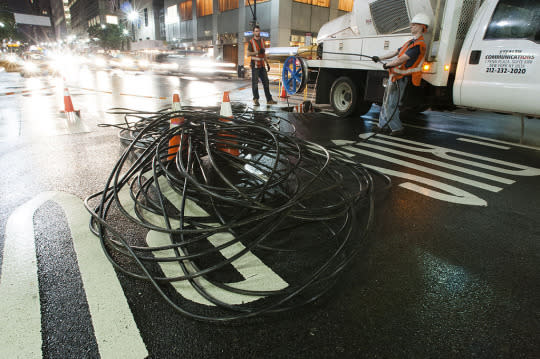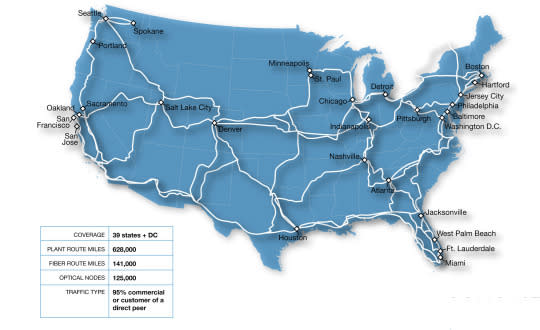It’s the 21st Century: Where's my Super-Fast Broadband Fiber?

(Photo: Thinkstock).
Handheld computers? Check. Wrist-bound communicators? Got ‘em. Jetpacks? For some of us, yes. A global fiber network enabling the blazingly fast delivery of information and entertainment services? Well, we’re getting there.
Right now, slightly less than a quarter of all U.S. households have access to fiber broadband, according to Heather Gold, president and CEO of Fiber to the Home Council in Washington. Of those who do have access to fiber, about half — 12.3 million, according to Gold’s estimate — will actually be connected to it by the end of 2015.
But even as fiber providers — ranging from the big cable and phone operators down to small local providers in rural communities — tackle the job of rolling out fast, fiber-based broadband, it’s going to be years before even half of the U.S. has access to high-speed fiber networks.
Fiber providers
Verizon Communications is the largest provider of fiber networks to end users in the US, covering 14 states, according to broadbandnow.com (which tracks all types of broadband deployment, including fiber). Verizon’s FiOS provides phone service, video programming, and Internet access with speeds up to 500 megabits per second (Mbps) to homes in its targeted metropolitan areas.
Of course you’ve heard about Google Fiber, which delivers service — with speeds up to 1 gigabit per second (Gbps) — to targeted communities including Austin and Kansas City. Google Fiber is fairly new in the fiber-to-the-home world, but it’s making a big splash because of its high speeds, and the simple fact that it’s part of Google.

Want to know if Google Fiber is coming to your town? Just plug in your address at the Big G’s site to find out if you’re one of the anointed.
But while those are two of the best known fiber providers, in reality there are hundreds of others in the U.S. Some — such as Time Warner Cable and Comcast — are best known as cable companies, but they also provide fiber to the home in some markets.
On the other end of the scale are small telephone companies such as the Oran Mutual Telephone Company in Iowa, which serves 637 people in that rural community. In between are fiber systems operated by phone companies and in some cases communities themselves. The city of Camilla, Georgia, for example, operates a municipal fiber network in that southwest Georgia community. In many cases, those smaller phone companies and communities operate regular cable networks in addition to their fiber ventures.
In some of these smaller markets, the fiber roll-out is being driven by funding from the FCC: Its Universal Service Fund — which is supported by charges to our telephone and broadband bills — is mandated to help broadband deployments in underserved areas. But it’s also driven by a desire to improve access in communities who see such fast connections as the key to economic competitiveness, better education, and better healthcare.
According to Gold, access to fiber is growing by about 10 percent a year in the U.S. At that rate of growth, it’s estimated that half of the U.S. will have fiber in about seven years.
Stumbling blocks
That’s not to say the expansion of fiber will be easy or cheap.
Community-based fiber systems have faced restrictions in some areas such as Tennessee, where state regulators have ruled that localities don’t have the authority to build outside their respective jurisdictions. That ruling has been overturned by the FCC, but the state is appealing; meanwhile, everything is on hold.
Fiber deployments in older urban areas in the northeast can be hindered because the conduits under the streets are already awfully crowded. In some older cities, historic designations limit what fiber providers can do. In less crowded areas, the companies that own the power and communications poles may demand high rents from anyone who seeks to string fiber on them — or they may bar access entirely.

Workers from Stealth Communications install fiber optic cable under the streets of Manhattan (Photo: Shuli Hallak/Wikimedia).
Burying fiber is easier in some areas than others. Property owners may object to having their yards or streets dug up. Conflicting laws and jurisdictions muddle the matter. (One potential fix for both of these problems: If a proposed law makes it through Congress, fiber conduits would become part of most federally-funded highway construction; that could lower the cost and ease the delays in fiber implementation.)
But by far the biggest hurdle facing fiber is economic. It’s expensive for companies to put it in, thanks to the combined costs of construction, acquiring the necessary access rights, and materials. Costs can easily be tens of millions of dollars for any given community. For a fiber installation to make sense, those costs must be recovered, somehow.
While the details vary widely, most providers are charging customers a one-time “construction fee” in addition monthly service bills of $100 and $500 dollars per month. But they’re still competing with legacy broadband services, which are no longer trying to recoup their initial construction outlays. That puts an upper cap on what fiber providers can expect to charge their customers. So, for example, Google Fiber is currently being offered in Kansas City for $130 per month, with the usual one-time $300 construction fee waived.
The Future of Fiber
There’s no question that high-speed fiber with speeds of 1 Gbps or more is on the way for many Americans. But nobody expects it to be universal. There are areas that are too remote or too sparsely populated to make fiber deployment feasible. For customers in these markets, high-speed Internet access will mean fixed wireless service or satellite broadband.

Comcast claims to have the “first and largest 40G fiber optic network” in the United States (Image: Comcast).
But elsewhere, fiber broadband continues to evolve. Comcast has already announced Gigabit Pro, a 2Gbps fiber network that’s starting in Atlanta (which just happens to be one of the cities targeted by Google Fiber).
Google, meanwhile, has announced the next phase of its expansion plans for its gigabit fiber. “We look for cities with tech-savvy, entrepreneurial residents who are excited about using new technology like gigabit connections,” Jill Szuchmacher, director of Google Fiber expansion said in an email. “Our Fiber cities have diverse businesses that can take full advantage of gigabit Internet and develop new applications to transform their industries.”
“We’re going to have a community by community groundswell,” said Heather Gold, “Everybody wants to have it,” she said. It won’t happen overnight. But it is coming.
More stories from Yahoo Tech:
Siri vs. Cortana, Google Now, and Alexa: Which Voice Assistant Will Win?
The 5 Biggest Myths About Smartphone Batteries (and Why They’re Mostly False)
Wayne Rash is senior columnist for eWEEK and a longtime writer about aviation and space. He has been a pilot since 1970. He can be reached at wayne@rash.org.
